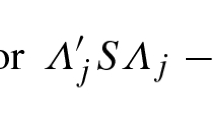Abstract
A distinction is made between statistical inference and psychometric inference in factor analysis. After reviewing Rao's canonical factor analysis (CFA), a fundamental statistical method of factoring, a new method of factor analysis based upon the psychometric concept of generalizability is described. This new procedure (alpha factor analysis, AFA) determines factors which have maximum generalizability in the Kuder-Richardson, or alpha, sense. The two methods, CFA and AFA, each have the important property of giving the same factors regardless of the units of measurement of the observable variables. In determining factors, the principal distinction between the two methods is that CFA operates in the metric of the unique parts of the observable variables while AFA operates in the metric of the common (“communality”) parts.
On the other hand, the two methods are substantially different as to how they establish the number of factors. CFA answers this crucial question with a statistical test of significance while AFA retains only those alpha factors with positive generalizability. This difference is discussed at some length. A brief outline of a computer program for AFA is described and an example of the application of AFA is given.
Similar content being viewed by others
References
Anderson, T. W. and Rubin, H. Statistical inference in factor analysis.Proc. third Berkeley Symp. math. Statist. and Prob., 1956,5, 11–50.
Bargmann, R. A study of independence and dependence in multivariate normal analysis. Institute of Statistics, Univ. North Carolina, Mimeographed Series No. 186, 1957.
Caffrey, J. Algorithm 66. INVRS.Communications of the ACM, 1961,4, 322.
Cronbach, L. J. Coefficient alpha and the internal structure of tests.Psychometrika, 1951,16, 297–334.
Cronbach, L. J., Rajaratnam, N., and Gleser, G. C. Theory of generalizability: a liberalization of reliability theory.Brit. J. statist. Psychol., 1963,16, 137–163.
Cronbach, L. J. and Hartmann, W. A note on negative reliabilities.Educ. psychol. Measmt, 1954,14, 342–346.
Dickman, K. and Kaiser, H. F. Program for inverting a Gramian matrix.Educ. psychol. Measmt, 1961,21, 721–727.
Guttman, L. A basis for analyzing test-retest reliability.Psychometrika, 1945,10, 255–282.
Guttman, L. “Best possible” systematic estimates of communalities.Psychometrika, 1956,21, 273–286.
Guttman, L. To what extent can communalities reduce rank?Psychometrika, 1958,23, 297–308.
Harris, C. W. Some Rao-Guttman relationships.Psychometrika, 1962,27, 247–263.
Holzinger, K. J. and Harman, H.Factor analysis. Chicago: Univ. Chicago Press, 1941.
Hotelling, H. Analysis of a complex of statistical variables into principal components.J. educ. Psychol., 1933,24, 417–441, 498–520.
Hoyt, C. Test reliability estimated by analysis of variance.Psychometrika, 1941,6, 153–160.
Jackson, R. W. and Ferguson, G. A. Studies on the reliability of tests. Bulletin No. 12, Dept. of Educ. Res., Univ. Toronto, 1941.
Kaiser, H. F. The varimax method of factor analysis. Unpublished doctoral dissertation, Univ. Calif., 1956.
Kaiser, H. F. The varimax criterion for analytic rotation in factor analysis.Psychometrika, 1958,23, 187–200.
Kaiser, H. F. The application of electronic computers in factor analysis.Educ. psychol. Measmt, 1960,20, 141–151.
Kaiser, H. F. Comments on communalities and the number of factors. Unpublished manuscript, 1960.
Kuder, G. F. and Richardson, M. W. The theory of the estimation of test reliability.Psychometrika, 1937,2, 151–160.
Lawley, D. N. The estimation of factor loadings by the method of maximum likelihood.Proc. roy. Soc. Edinburgh, 1940,60, 64–82.
Lord, F. M. Some relations between Guttman's principal components of scale analysis and other psychometric theory.Psychometrika, 1958,23, 291–296.
Rao, C. R. Estimation and tests of significance in factor analysis.Psychometrika, 1955,20, 93–111.
Thurstone, L. L.Multiple-factor analysis. Chicago: Univ. Chicago Press, 1947.
Tryon, R. C. Reliability and behavior domain validity: Reformulation and historical critique.Psychol. Bull., 1957,54, 229–249.
Author information
Authors and Affiliations
Additional information
The first version of this paper was prepared while the senior author was a U. S. Public Health Service Fellow at the Center for Advanced Study in the Behavioral Sciences and while the junior author was Director of Research of the Palo Alto Public Schools.
Rights and permissions
About this article
Cite this article
Kaiser, H.F., Caffrey, J. Alpha factor analysis. Psychometrika 30, 1–14 (1965). https://doi.org/10.1007/BF02289743
Received:
Revised:
Issue Date:
DOI: https://doi.org/10.1007/BF02289743




